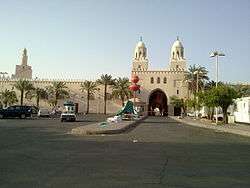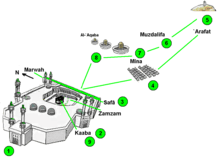Meeqath

Mīqāt (Arabic: ميقات, meaning 'a stated place') are the principal boundary points of the area within which Muslim pilgrims on the Hajj must be in the state of ihrām (a state of consecration in which certain worldly activities are prohibited). These prohibited activities include clipping the nails, shaving any part of the body, having sexual relations; using perfumes, damaging plants, killing animals, covering one's head (for men) or one's face and hands (for women); getting married; or carrying weapons.[1][2]
The mīqāt[3]
Five of the six mīqāts were appointed by the Prophet Muhammad. The sixth mīqāt was appointed at a later date for the convenience of travelers from India and other countries east of the Arabian peninsula.
The mīqāts are as follows:
1. Dhu'l-Hulayfah - This mīqāt is about 9 kilometres (5.6 mi) from Medinah and about 450 kilometres (280 mi) from Mecca. Dhu'l-Hulayfah is the mīqāt for those who live in Madinah and for those who approach Mecca from the direction of Medinah.
2. Juhfah - This mīqāt is about 190 kilometres (120 mi) to the northwest of Mecca. This is the mīqāt for the people who come from the direction of Syria.
3. Qarn ul-Manāzil - Also known as Mīqāt Al-Sail, located 85 kilometres (53 mi) from Mecca, in a small town known as As-Sail Al-Kabeer on Highway 40. This mīqāt serves pilgrims coming from the Najd region which is generally the middle of Saudi Arabia.
4. Yalamlam - This mīqāt point serves the Hujajj coming from the direction of Yemen. Yalamlam is a small city in the province of Makkah.
5. Dhāt-i 'Irq - This mīqāt is about 85 kilometres (53 mi) northeast of Mecca. This mīqāt serves pilgrims coming from the direction of Iraq, Iran, and other places en route. The mīqāt is situated in a very rural location, 58 kilometres (36 mi) from Highway 40, the main Taif-Riyadh road.
If one intends to travel to Makkah for either the pilgrimage of the Hajj or Umrah one should wear one's Ihram at these mīqāt stations. The state of Ihram goes beyond one's clothing and it is considered most important to enter a spiritual state of mind.
Entering the mīqāt by air
When flying to Mecca it is necessary to wear one's Ihram before one's plane enters the mīqāt zone in the air. Jeddah is within the mīqāt zone as a line from the southernmost mīqāt at Yalamlam to the northwestern mīqāt at Juhfah includes Jeddah in the zone. Pilgrims either wear the garments of ihram from their airport of departure, or they don them on the plane. Pilots announce entering the mīqāt about 30 minutes prior so that pilgrims can go to the restroom and change.
Al-Hil
Al-Hil refers to the area between the boundaries of the and the boundaries of the Haram. Towns and cities such as Jeddah, Khulais, al-Janun, and Taneem are all situated within al-Hil.
Pilgrims residing in or travelling through al-Hil must enter into a state of ihram before crossing the boundary of the Haram. For example, a person who travels to Jeddah for business purposes and wants to perform umrah at a later stage may enter into ihram in Jeddah or before crossing the boundary of the Haram.
If an individual from al-Hil has the intention of entering Mecca for another purpose, such as praying salah at the Haram or visiting friends or relatives, ihram is not required. If after entering Mecca, the individual decides to perform umrah, s/he will need to assume ihram at the boundary of the Haram.
Al-Haram
The Haram is the sacred precinct of Mecca within which certain acts are considered unlawful which may be lawful elsewhere. It is prohibited to hunt wild animals, damage any plant or tree, graze animals, carry weapons, fight, or behave in a manner that will violate the sanctity of Masjid al-Haram. If a violation is carried out within the precinct of the Haram, an animal sacrifice (damm) or gift of charity (sadaqah) is required as expiation.
The boundaries of the Haram are as follows:
1. Taneem – Masjid Aisha, also known as Masjid Taneem, located about 8 kilometres (5.0 mi) from the Kaaba and 5 kilometres (3.1 mi) away from Mecca, in the direction of Madinah.
2. Adaat Laban – On the road to Yemen, 11 kilometres (6.8 mi) away from Mecca.
3. Wadi Nakhla – On the road to Iraq, 11 kilometres (6.8 mi) away from Mecca.
4. Arafat – On the road to Ta’if, close to Masjid al-Namirah in Arafat, 11 kilometres (6.8 mi) away from Makkah.
5. Ji’ranah – Masjid al-Ji’ranah, located about 14 kilometres (8.7 mi) away from Mecca.
6. Hudaibiyah – Masjid al-Hudaibiyah, on the road to Jeddah, about 16 kilometres (9.9 mi) away from Makkah.
Additional Umrah
If a pilgrim intends to perform an additional umrah, ihram must be assumed outside the boundary of the Haram before reentering Mecca to carry out the rites of umrah. Many pilgrims choose to enter into the state of ihram at Masjid Aisha which is the nearest and most convenient location from Masjid al-Haram. The condition to perform umrah from this mīqāt is that you should be a resident of Mecca and/or have entered into Mecca for more than 15 days. Transportation to get to this location is readily available near the mosque. Additional umrah, if a person so intends, can be done by assuming Ihram at any of the six mīqāt points.
References
| Wikimedia Commons has media related to Meeqath. |
- Hughes, Thomas Patrick (1994). Dictionary of Islam. Chicago, IL: Kazi Publications Inc. USA. ISBN 0-935782-70-2.
- Notes
- ↑ Nigosian, S. A. (2004). Islam: Its History, Teaching, and Practices. Indiana: Indiana University Press. p. 111. ISBN 0-253-21627-3.
- ↑ "ihram". Encyclopædia Britannica. 2014. Retrieved 6 October 2014.
- ↑ "Meeqath | Hajj & Umrah Planner". hajjumrahplanner.com. Retrieved 2017-04-10.
